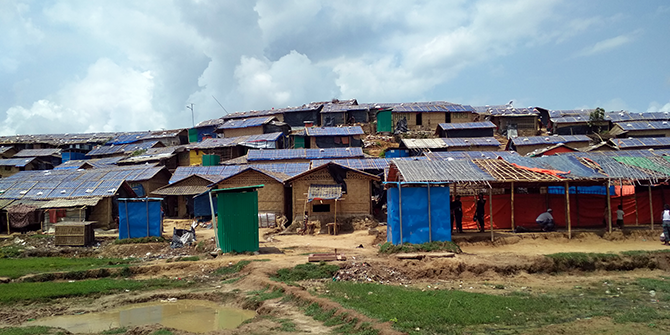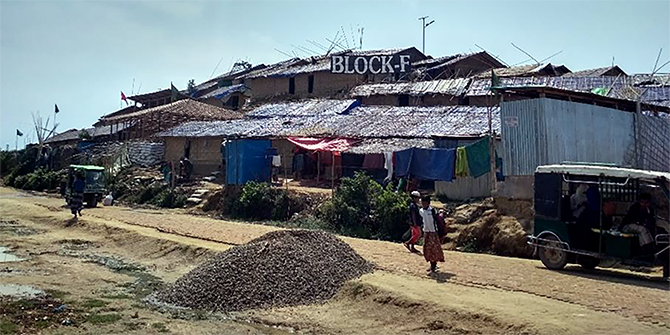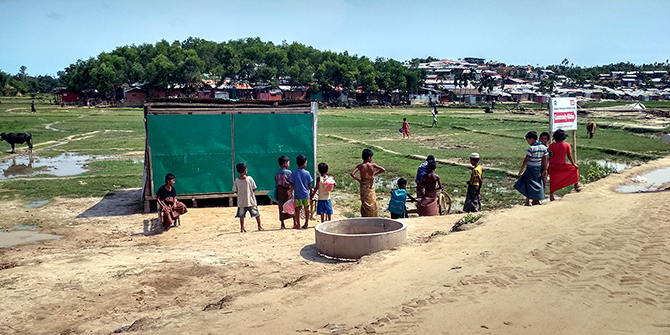
Jun Hao Peh reflects on his project which distributed 600 solar powered lamps to Rohingya refugees in Bangladesh.
6 months ago, I applied to the Davis Projects for Peace Prize, as a delegate from International Students House in London, with a proposal for a project to purchase and distribute solar powered lamps to Rohingya refugees in camps in Bangladesh. The prize awards university students with $10,000 to execute a project of their choice, using their creativity to help promote peace around the world. I had become aware of the Rohingya crisis through news reports, as well as covering it on the LSE100 course, and following further research I developed the idea for ‘Project Illuminate’. In the camps many of the refugees use oil lamps, which are not only a fire hazard, but also unsustainable and unreliable given the lack of resources. The aim of the project was to improve safety and quality of life in the camps, by providing safe and sustainable lighting which doesn’t rely on costly fuel or batteries.
The plight of the Rohingya people might have gained international prominence only recently, but the underlying violence has been built on generations of pre-existing conflict and persecution. The Rohingyas are an ethnic and religious minority in Myanmar and have sought refuge from violence and political tensions on several occasions since the first camp appeared in Bangladesh during the 1978 refugee crisis. August 2017 saw the start of the biggest movement of people to date, with a mass exodus of Rohingya people fleeing large-scale violence by Myanmar’s military forces, leading to the current refugee crisis which has caught the world’s attention.
A challenge on many levels
Having always wanted to do something meaningful for the less privileged, Project Illuminate felt like an important and valuable opportunity. Moreover, coming from an ASEAN (Association of Southeast Asian Nations) country, the Rohingya crisis was especially significant to me in terms of its proximity to home. Realising the project was challenging on many levels and coordination was key to ensuring that it ran smoothly and the operational conditions were just right.

A major issue was the uncertainty of the logistical infrastructure within the country and, perhaps more importantly, coordinating with partners in a foreign land who spoke a different language. Timing was also critical. Everything had to be planned within a span of 3 months, and due to the approaching summer monsoon season in Bangladesh I had to move the project start date earlier by two weeks (right after my last examination) as heavy monsoon rains would have made accessing the refugee camps difficult, if not impossible. The central task of sourcing 600 solar powered lamps also came with its own problems as, due to a lack of stock, special arrangements had to be made to fly additional lamps over from China.
The project took place in May 2018 in Jamtoli camp, where approximately 11,000 families and close to 50,000 refugees reside. This camp is one of the smallest out of the 25 that have been created during the current refugee crisis and is divided into 8 blocks. After close consultation with the army commander operating within the camp, we decided that Block F would be the most suitable location to carry out the project.
Working in Jamtoli camp gave me an insight into the conditions in the camps and the daily lives of the project beneficiaries. There were clear signs of hygiene issues, with many areas lacking proper sanitation facilities and numerous water-logged areas contributing to water-borne diseases within the camps. Children were frequently seen mishandling objects, such as dangerous wires, and playing in places where construction was occurring. Another urgent issue was the prospect of a new wave of abandoned new-borns conceived as a result of rape during the violence in Myanmar, as their parents may not accept them or feel unable to care for them in such a difficult situation.

Whilst working on the project I observed different management structures within the camps and saw how NGOs had to step up to serve the needs of refugees when the resources of government bodies proved insufficient due to the sudden influx of people. It was interesting to witness the coordination between NGOs working to ensure refugees had access to essential items, such as food, medical supplies and toiletries, and there was a clear structure in place. Granted, I visited the camps 8 months after the first influx of refugees so there had been time to set processes in motion, but I was still impressed with the organisation between all the different parties involved. However, given the large number of organisations working in these camps, it still remains a massive challenge to ensure that all the needs of the refugees are met and are neither side-lined or overlapped.
Somehow people find a way to carry on
A significant challenge these camps face is a lack of volunteers for many of the more pastoral and social care services required, such as trauma care and child protection. This type of care, unlike food or non-perishables items, cannot be distributed or built into a mechanised process. This is only exacerbated by the lack of professionals within the camp – there are simply too many in need without the adequate numbers of workers to support them. Without proper care children and young people subjected to these conditions can face serious psychological problems in future, which may ultimately perpetuate a cycle of violence.
In the context of such a large-scale humanitarian crisis, innovations have to be found quickly and unconventional steps have to be taken to in order to tackle problems with the often-limited resources available on the ground. Being responsive and dynamic given these constraints is crucial in order to minimise the dangers and find the best solutions in a difficult situation. This means that rather than the usual process of predicting trends and forecasting issues, at least in the short term, such crises have to be dealt with differently. Without the luxury of advance planning or a precedent course of action, the impetus is on minimising the casualties of a sudden new reality where so many lives are at stake. From a policy perspective, the management of the current Rohingya refugee crisis has been dictated by the scale and speed of the mass-movement of refugees; I sometimes wonder how things might differ in a situation where the process is more gradual and if the world would sit up and take notice in the same way.

Personally, perhaps one of the most striking lessons that I’ve learnt from the refugee camps is that despite all the hardships and difficulties, life goes on, one way or another. I saw children playing beside piles of trash, happily chasing one another, making the best out of what they had. I witnessed a young teenager taking care of her even younger sibling, forced into adulthood at such an early age after their parents were killed in the violence. Life is undeniably difficult in refugee camps, but somehow people find a way to carry on. Their resilience is something that must be acknowledged and learnt from.
(All photographs by Jun Hao Peh)
 Jun Hao Peh is a BSc Government and Economics student in the LSE Department of Government who is interested in the research of public institutions and their impacts on the economic policies. He is also passionate about social mobility, especially its engagement within the institutional framework.
Jun Hao Peh is a BSc Government and Economics student in the LSE Department of Government who is interested in the research of public institutions and their impacts on the economic policies. He is also passionate about social mobility, especially its engagement within the institutional framework.
Note: this article gives the views of the author, and not the position of the LSE Department of Government, nor of the London School of Economics.





